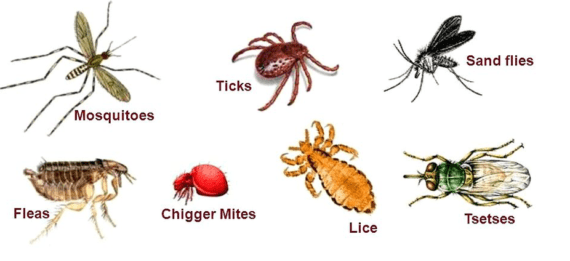
They are small arachnids that feed on human and animal blood to survive. These parasites make their habitat in wooded areas and fields. Also, they are known to carry several harmful diseases that they transmit to their host when they bite them.
Fleas are small, flat insects that, like ticks, need human and animal blood to survive. Fleas are wingless creatures and mainly target the hairy parts of mammals and the plumage of birds as their feeding ground. Globally, there are more than 2,400 species of fleas. However, only a few of these species feed on humans and animals.
 The Difference Between a Flea and Tick
The Difference Between a Flea and Tick
Ticks are classified as arachnids, while fleas are insects. They also target a different assortment of hosts.
Fleas tend to have fewer hosts as compared to ticks. For example, some hosts for fleas are:
The list of possible hosts for tick is longer, including:
Apart from these attributes, they also differ with a number of their other characteristics.
Without hosts, both fleas and ticks will not be able to survive. These parasites spread easily once they find a host. Some common overall causes that lead to a flea and tick infestation include:
However, bear in mind the fact that these are just a collection of the most common causes that lead to flea and tick infestations. There are numerous species of fleas and ticks worldwide, and each of them can be present in an environment due to any number of different factors.
The several types of ticks and fleas and the illnesses they cause make it even more important that we focus on developing flea and tick prevention programs.
Fleas and ticks are known to attach themselves to any part of your body. Some common flea and tick infestation areas include:
Often, people may not check these areas for a flea or tick bite. In the interest of making you more informed, here is a list of the symptoms that can occur due to a flea or tick bite.
Flea bites can cause either an allergic reaction or a secondary infection in humans. If you experience any of these adverse side-effects, contact your doctor immediately.
Tick bites have their own set of complications. Some people may have an allergic reaction to them. The symptoms include:
Ticks are also known to carry diseases. The signs of a tick disease include:
There are numerous remedies for treating flea bites. These range from simple home remedies to over-the-counter medicines. Some treatments include:
For flea control, these are suggested guidelines:
Controlling fleas on pets can be achieved through:
Also, regular visits to the vet will ensure that your pet is checked and groomed properly. At home, you should also keep a close tab on your pet and groom them at home as well.
The same aforementioned treatment and control should be followed for ticks. However, you may remove the tick at home using tweezers and then show it to your doctor. The doctor may then prescribe a specific treatment for you accordingly.

Canada Canadian Pharmacy dispenses all medications from licensed and regulated independent pharmacy partners internationally, including but not limited to Australia, Canada, New Zealand, India, Mauritius, Turkey, United States, Singapore and the United Kingdom. All Images on this site are registered trademarks of original manufacturers, international exporters, and property of their respective owners and are for reference only. Canada Pharmacy Online procures all products from licensed regulated international in order to provide you unbeatable lowest prices and prescription discounts for all your prescription medications, medications and Canadian Drugs at Canada Pharmacy Online.
2005-2023 Rxdrugscanada.com